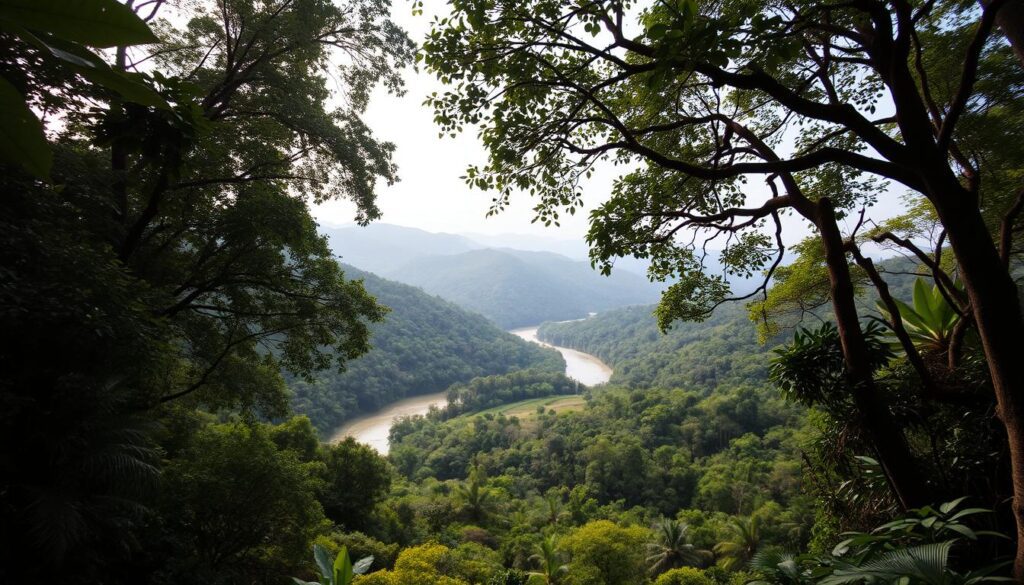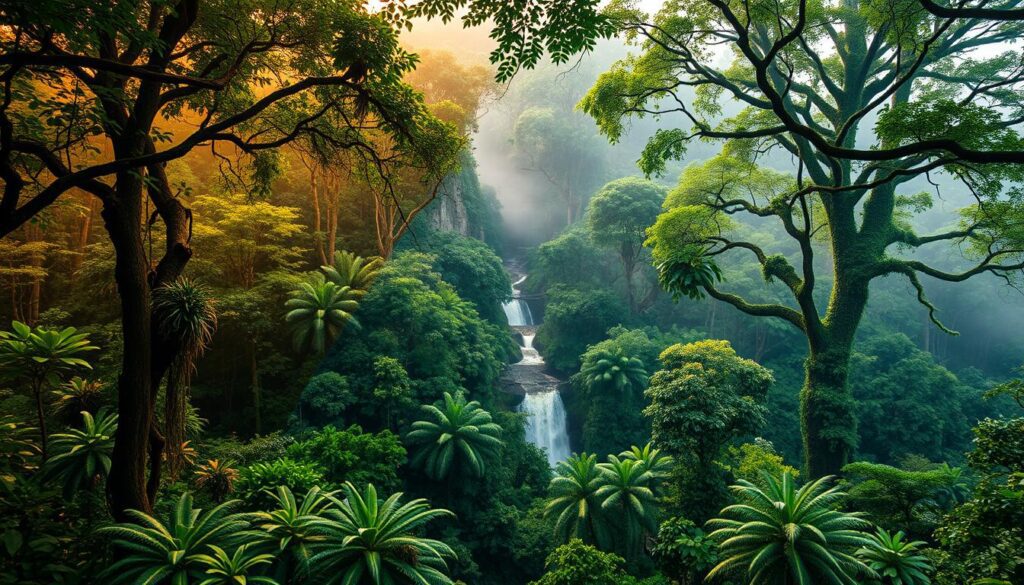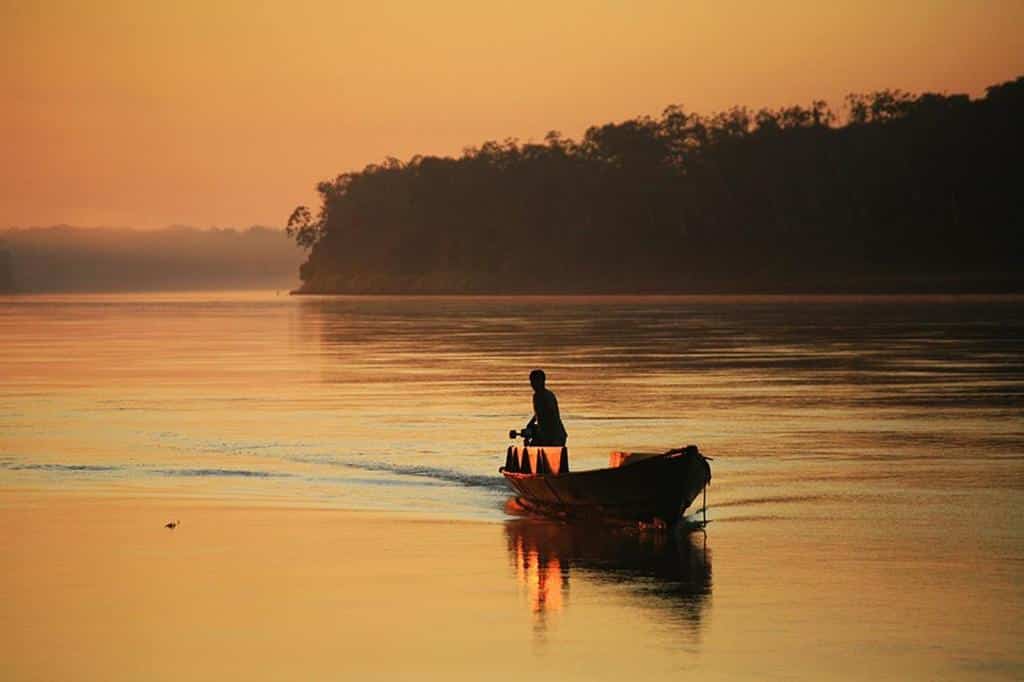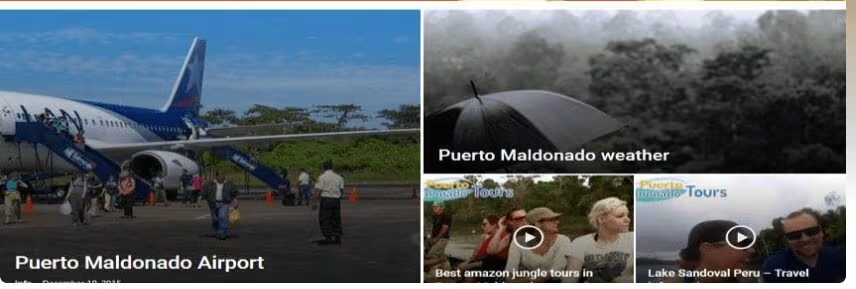Explore the Wonders of Tambopata in Peru

Tambopata in Peru is a hidden gem where the peruvian amazon comes alive. This region, part of the Amazon rainforest, offers untouched landscapes and rare wildlife. From towering trees to vibrant macaws, the tambopata area is a nature lover’s paradise.
Visitors can explore the peru rainforest through guided hikes, boat trips, and jungle lodges. The area’s biodiversity includes jaguars, pink river dolphins, and over 600 bird species. Tambopata National Reserve protects these ecosystems, making it a must-visit for adventure seekers.
Key Takeaways
- tambopata is a top destination for wildlife and eco-tourism.
- Explore the peruvian amazon in a region with minimal human impact.
- See unique species like harpy eagles and giant otters in their natural habitats.
- The peru rainforest offers diverse activities, from birdwatching to river cruises.
- Tambopata’s conservation efforts protect one of Earth’s most biodiverse areas.
Discovering Tambopata: Peru’s Natural Paradise
Tambopata Province is in the heart of the Amazon Basin. It’s a journey through time and nature. Long before explorers came, the Ese’Eja people lived here for centuries. They had a deep connection with the rainforest.
Later, the rubber boom changed things. But now, conservation efforts protect the wild landscapes.
The Rich History of Tambopata Province
For centuries, Tambopata has been shaped by humans. Local guides share ancient knowledge of plants and living sustainably. In the 1900s, rubber barons took a lot from the area.
But in 1990, the Tambopata National Reserve was created. It’s a 1.3-million-acre area that protects jaguars, macaws, and giant ceiba trees.
“The reserve’s creation marked a turning point for preserving Amazonian biodiversity,” says Dr. Ana Mendoza, a regional ecologist.
Why Tambopata Deserves a Spot on Your Bucket List
- Unparalleled wildlife encounters: Spot harpy eagles and pink river dolphins
- Unique Peru travel experiences: Sleep in canopy towers or paddle blackwater rivers
- Community-led eco-tours connecting visitors with native traditions
Tambopata National Reserve Highlights
Guided hikes show hidden waterfalls. Boat tours reach remote lagoons. The reserve follows strict sustainability rules.
Birdwatchers come for over 600 species, including the rare hoatzin.
The Remarkable Biodiversity of the Tambopata Region
Tambopata’s biodiversity in peru is truly amazing. It’s in the heart of the amazon jungle. Here, over 600 bird species, 170 mammal types, and more than 1,200 butterfly species live. It’s like a nature lab.
So many species live here because of the unique mix of ecosystems. The Amazonian lowlands, Andean foothills, and seasonal wetlands all meet here. This creates perfect conditions for life to thrive.
Visitors might see a giant otter in oxbow lakes or black caimans on riverbanks. Even the jungle wildlife here is incredible. Pink river dolphins, howler monkeys, and jaguars all live here.
- Over 1,200 butterfly species, including striking morphos
- 10% of the world’s known bird species found in Peru are here
- Home to endangered species like harpy eagles and giant otters
Conservation efforts protect these treasures for the future. For travelers, every hike or boat ride is a chance to see nature up close. From tall trees to tiny insects, Tambopata shows us why saving biodiversity in peru is crucial for our planet.
Must-See Natural Attractions in Tambopata
Tambopata is home to hidden lakes and vibrant bird displays. These sights are unforgettable and full of natural beauty. They also play a big role in the local ecosystem.
Lake Sandoval: A Pristine Oxbow Lake

Lake Sandoval is a hidden treasure. It was created when a river changed its course. Boat tours here let you see giant river otters and black caimans up close.
Going on a boat tour early in the morning is best. This way, you have a good chance of seeing these rare animals.
Macaw Clay Licks: Nature’s Colorful Spectacles
“Watching hundreds of macaws flock to the clay cliffs is like a rainbow taking flight.”
Places like Collpa Colorado are where parrots and macaws go to eat clay. This clay is full of minerals. It’s a sight to see, with birds of every color flying around.
Guides say the best time to visit is before 9 AM. This is when the birds are most active.
Jungle Canopy Towers and Walkways
- Walk suspended 100 feet aboveground on canopy walkways for treetop views
- Spot howler monkeys, toucans, and harpy eagles in their natural habitat
- Towers like the Tamarind canopy tower offer sunrise viewing platforms
Encountering Jungle Wildlife
Guided hikes and night tours show you the jungle’s hidden life. You might see tapirs, peccaries, and poison dart frogs. Visiting places like Lake Sandoval, Macaw Clay Licks, and Canopy Walkways increases your chances of seeing wildlife.
Best Times to Visit the Tambopata Rainforest
Planning your rainforest tours to Tambopata? Timing is key. Whether you like dry trails or wet season sights,

Dry Season Adventures (May-October)
May to October is dry season. Expect sunny days and easy trails. It’s the best time for eco-tourism like hiking and wildlife watching. The benefits are:
- Warmer mornings with cooler evenings
- Less mosquito trouble
- Access to remote spots is easier
Wet Season Wonders (November-April)
November to April sees more rain, making the forest green and lush. Trails might be wet, but it’s quieter. You’ll find:
- Lower lodging prices (up to 30% off)
- Great bird-nesting views
- Less crowded trails
Wildlife Viewing Calendar
| Month | Key Activity |
|---|---|
| May-Jun | Scarlet macaw mating rituals |
| Sept-Oct | Puca titi monkey breeding season |
| Jan-Feb | Jaguar sightings near riverbanks |
| Mar-Apr | Amazonian tapir foraging peaks |
Match your Peru travel plans with this guide. Both seasons have their charm. Pick what you like and get ready for adventure anytime!
How to Reach Tambopata from Puerto Maldonado
Your adventure starts in Puerto Maldonado, the entrance to the Peruvian Amazon. Most people fly into Padre Aldamiz International Airport. This airport connects from Lima or Cusco. Then, you travel by road and river to the Amazon jungle.
A 45-minute drive from the city leads to the river. Next, a motorized boat or canoe takes you along the Tambopata River. You’ll see dense greenery and maybe some wildlife. The trip takes 30 minutes to 4 hours, depending on your lodge’s location. Many eco-lodges offer transport, making it easier.
- Check with your lodge for exact departure times and luggage limits.
- Keep essentials like water, sunscreen, and a camera in a small bag for easy access.
- Wear waterproof shoes—the journey can get muddy!
As the boat goes deeper into the Peruvian Amazon, the city sounds fade away. This 60-mile stretch is more than just a trip—it’s your first jungle experience. Guides might show you herons or monkeys. By the time you arrive, you’re already surrounded by Tambopata’s beauty.
“The boat ride feels like slipping into another world,” says local guide Maria. “Even the shortest trips feel like an adventure.”
Planning ahead makes your trip smooth. Most visitors find going from Puerto Maldonado to Tambopata easy, thanks to eco-lodges. Enjoy this journey—it’s a great start to the rainforest’s wonders.
Accommodation Options in the Heart of Tambopata
Choosing to stay in Tambopata means picking from unique lodgings that mix comfort with nature’s beauty. You can pick from jungle lodges to riverside retreats. Each place is a doorway to the rainforest’s secrets. They focus on being green, making your visit part of eco-tourism efforts.
Eco-Friendly Jungle Lodges
Places like Posada Amazonas and Refugio Amazonas offer both comfort and care for the environment. They use solar power, recycled water, and support local people. Lodges near Puerto Maldonado are easier to get to, while the remote ones let you dive deeper into nature. Look for Rainforest Alliance certification to know they’re doing it right.
Riverfront Cabanas and Retreats
Riverfront cabanas along the Tambopata River are great for a peaceful stay. They’re perfect for those who want to explore on their own. Imagine waking up to the sounds of macaws or kayaking at sunrise. It’s a way to really connect with the wild.
What to Pack for Your Tambopata Adventure
- Light, quick-dry clothes and waterproof boots
- Insect repellent, sunscreen, and a reusable water bottle
- Binoculars and a waterproof camera for wildlife
- Light rain gear and a daypack for rainforest tours
Travel light but smart. Many jungle lodges offer gear rentals. Choose breathable clothes to stay cool in the heat.
Conclusion: Embracing the Magic of Tambopata
Tambopata National Reserve is a true marvel of nature. It’s home to incredible wildlife, like macaws and jaguars, found nowhere else. Every visit helps protect these wild places for the future.
Traveling to Peru’s Tambopata is more than just seeing sights. By staying in eco-lodges and exploring with guides, you support conservation. This way, you help keep the Amazon alive. Imagine seeing harpy eagles soar, knowing you’re helping protect their home.
Exploring Tambopata is unforgettable. You’ll trek through green canopies and see caimans at dusk. Start looking for tours that care about the environment. By choosing these, you help protect this unique place. The Amazon’s secrets are waiting for those who explore responsibly.
FAQ
What makes Tambopata one of the most biodiverse regions in the world?
Tambopata is a hotspot for life. It has over 600 bird species and 1,200 butterfly types. Plus, it’s home to many mammals, reptiles, and plants. Its location at the crossroads of ecosystems makes it a perfect place for wildlife, attracting nature lovers and eco-tourists.
How do I get to Tambopata from Puerto Maldonado?
Getting to Tambopata is easy. First, fly to Padre Aldamiz International Airport. Then, take a road trip and a boat ride along the Tambopata River. Your lodge will arrange this, making your journey smooth.
What is the best time to visit Tambopata for wildlife viewing?
The dry season, from May to October, is great for seeing wildlife. The weather is nice, and it’s easy to get around. The wet season, from November to April, is perfect for lush views and unique wildlife behaviors. Both seasons offer amazing experiences.
Are there any eco-friendly accommodations in Tambopata?
Yes, there are many eco-friendly places to stay. You can choose from jungle lodges to riverfront cabanas. These places use solar power, manage waste, and help the community. They offer a responsible way to enjoy the rainforest.
What should I pack for my trip to Tambopata?
Pack light but smart. Bring clothes for humid weather, waterproof shoes, bug spray, sunscreen, and a water bottle. Don’t forget your camera for stunning views and wildlife photos!
Can I observe wildlife easily in Tambopata?
Yes, wildlife spotting is easy in Tambopata. You can see monkeys, otters, and colorful birds on walks, boat rides, or from lodges. It’s a memorable experience for all.
What should I know about the Collpa Clay Licks?
The Collpa Clay Licks are special spots where macaws and parrots eat clay. Seeing this colorful scene is a highlight. Visit early in the morning for the best views.
Are there any specific health considerations for traveling in the Tambopata region?
Yes, talk to your doctor about vaccinations and tropical disease meds. Also, get travel insurance that covers medical evacuations. This will help you relax and enjoy your trip.

